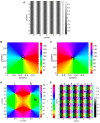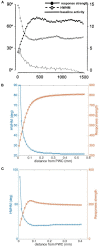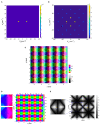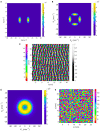Analytic Model for Feature Maps in the Primary Visual Cortex
- PMID: 35185503
- PMCID: PMC8854373
- DOI: 10.3389/fncom.2022.659316
Analytic Model for Feature Maps in the Primary Visual Cortex
Abstract
A compact analytic model is proposed to describe the combined orientation preference (OP) and ocular dominance (OD) features of simple cells and their mutual constraints on the spatial layout of the combined OP-OD map in the primary visual cortex (V1). This model consists of three parts: (i) an anisotropic Laplacian (AL) operator that represents the local neural sensitivity to the orientation of visual inputs; and (ii) obtain a receptive field (RF) operator that models the anisotropic spatial projection from nearby neurons to a given V1 cell over scales of a few tenths of a millimeter and combines with the AL operator to give an overall OP operator; and (iii) a map that describes how the parameters of these operators vary approximately periodically across V1. The parameters of the proposed model maximize the neural response at a given OP with an OP tuning curve fitted to experimental results. It is found that the anisotropy of the AL operator does not significantly affect OP selectivity, which is dominated by the RF anisotropy, consistent with Hubel and Wiesel's original conclusions that orientation tuning width of V1 simple cell is inversely related to the elongation of its RF. A simplified and idealized OP-OD map is then constructed to describe the approximately periodic local OP-OD structure of V1 in a compact form. It is shown explicitly that the OP map can be approximated by retaining its dominant spatial Fourier coefficients, which are shown to suffice to reconstruct its basic spatial structure. Moreover, this representation is a suitable form to analyze observed OP maps compactly and to be used in neural field theory (NFT) for analyzing activity modulated by the OP-OD structure of V1. Application to independently simulated V1 OP structure shows that observed irregularities in the map correspond to a spread of dominant coefficients in a circle in Fourier space. In addition, there is a strong bias toward two perpendicular directions when only a small patch of local map is included. The bias is decreased as the amount of V1 included in the Fourier transform is increased.
Keywords: cortical maps; ocular dominance; orientation selectivity; primary visual cortex (V1); receptive field (RF).
Copyright © 2022 Liu and Robinson.
Conflict of interest statement
The authors declare that the research was conducted in the absence of any commercial or financial relationships that could be construed as a potential conflict of interest.
Figures













Similar articles
-
Testing Hubel and Wiesel's "ice-cube" model of functional maps at cellular resolution in macaque V1.Cereb Cortex. 2024 Dec 3;34(12):bhae471. doi: 10.1093/cercor/bhae471. Cereb Cortex. 2024. PMID: 39657201
-
Mutual consistency of multiple visual feature maps constrains combined map topology.Phys Rev E. 2023 Jun;107(6-1):064401. doi: 10.1103/PhysRevE.107.064401. Phys Rev E. 2023. PMID: 37464602
-
Sensory experience modifies feature map relationships in visual cortex.Elife. 2016 Jun 16;5:e13911. doi: 10.7554/eLife.13911. Elife. 2016. PMID: 27310531 Free PMC article.
-
A spherical model for orientation and spatial-frequency tuning in a cortical hypercolumn.Philos Trans R Soc Lond B Biol Sci. 2003 Oct 29;358(1438):1643-67. doi: 10.1098/rstb.2002.1109. Philos Trans R Soc Lond B Biol Sci. 2003. PMID: 14561324 Free PMC article. Review.
-
Geometric visual hallucinations, Euclidean symmetry and the functional architecture of striate cortex.Philos Trans R Soc Lond B Biol Sci. 2001 Mar 29;356(1407):299-330. doi: 10.1098/rstb.2000.0769. Philos Trans R Soc Lond B Biol Sci. 2001. PMID: 11316482 Free PMC article. Review.
Cited by
-
Artificial Visual System for Stereo-Orientation Recognition Based on Hubel-Wiesel Model.Biomimetics (Basel). 2025 Jan 8;10(1):38. doi: 10.3390/biomimetics10010038. Biomimetics (Basel). 2025. PMID: 39851754 Free PMC article.
References
-
- Baspinar E., Citti G., Sarti A. (2018). A geometric model of multi-scale orientation preference maps via Gabor functions. J. Math. Imaging Vis. 60, 900–912. 10.1007/s10851-018-0803-3 - DOI
LinkOut - more resources
Full Text Sources
Miscellaneous

